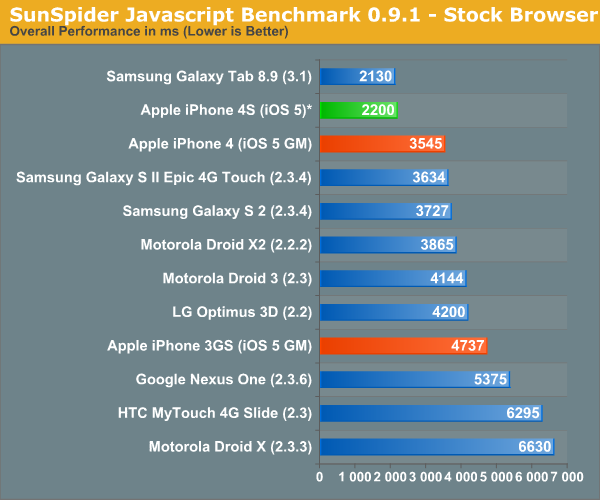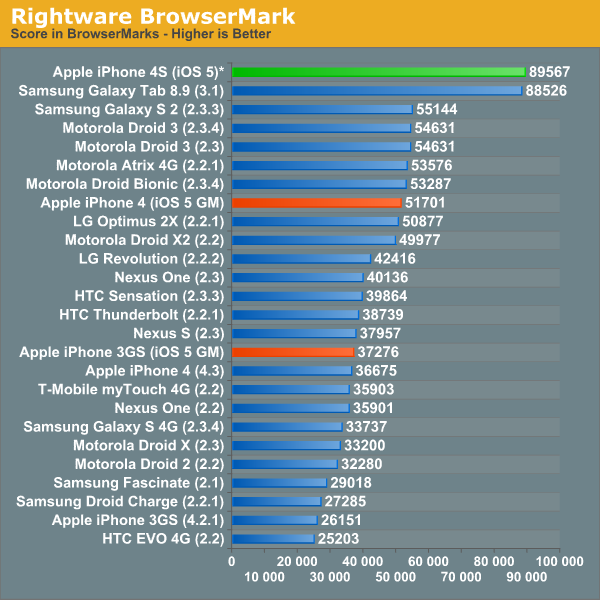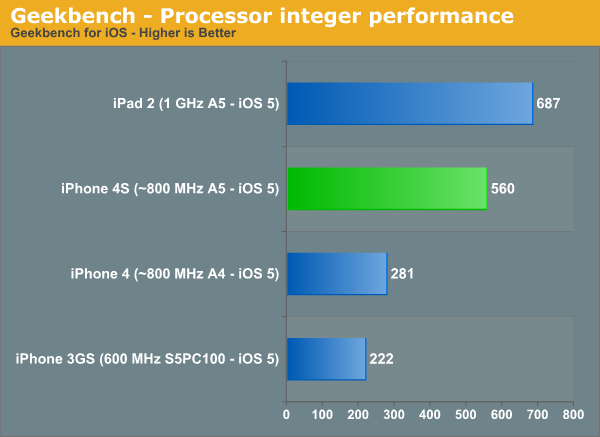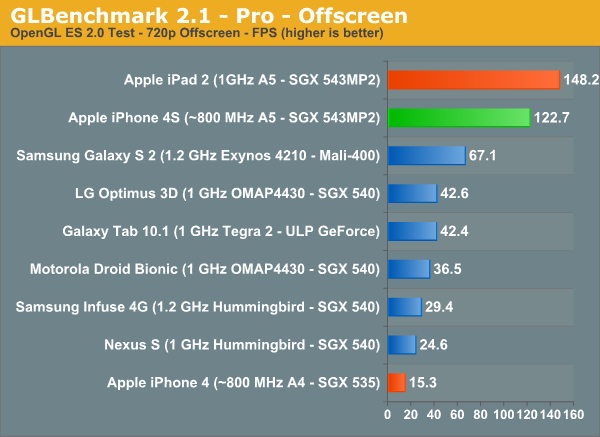iPhone 4S Preliminary Benchmarks: ~800MHz A5, Slightly Slower GPU than iPad 2, Still Very Fast
by Anand Lal Shimpi & Brian Klug on October 11, 2011 3:22 AM EST- Posted in
- Smartphones
- Apple
- Mobile
- iPhone 4S
- SoCs
Apple's ability to control the entire information chain, down to the point of limiting leaks, appears to be gradually slipping as it grows as a company. Case in point are the numerous hardware and performance leaks surrounding the newly launched iPhone 4S. Little did we know that several weeks ago we were staring at photos of the 4S' PCB, and more recently we've seen the first performance results from Apple's first A5 based smartphone thanks to a few eager users around the web. We've compiled these results here from various sources (all linked below) and compared them to our existing database of tests.
The results are pretty much as expected. Javascript performance finally catches up to Tegra 2 based Honeycomb devices, while general CPU performance is significantly higher than the iPhone 4. I suspect Ice Cream Sandwich will bridge the Android smartphone gap (the Honeycomb equipped Gtab 8.9 is here to give you an idea of where a more modern Android browser ends up).
Keep in mind that all of these tests measure performance of the software stack in addition to the hardware. In particular the web browser tests depend largely on browser optimizations, which is why we see differences between similar hardware running different browser versions. Also note that all results were run at stock, with the stock browser. Finally, although these browser tests were captured on video we'll still be running our official tests once our 4Ses arrive and will update accordingly.


Using some of the integer and fp tests of published Geekbench scores we can already conclude that Apple is shipping a lower clocked A5 in the iPhone 4S than it does in the iPad 2. This naturally makes sense as the iPhone 4S has a much smaller 5.25 Whr battery. Based on the Geekbench results it looks like the iPad 2 is clocked around 25% higher than the iPhone 4S, pegging the latter's clock speed at 800MHz.


A lower clock not only means higher yields from the factory, but likely a lower operating voltage as well. Dropping a CPU's core voltage, yields a greater-than-linear decrease in power consumption, making the marginal loss in clock speed a good choice. At a lower operating frequency than its Android competitors, Apple does have to exploit its strengths in software to avoid any tangible performance penalties. Apple has traditionally done this very well in the past, so I don't expect the loss of frequency to be a huge deal to the few who do cross-shop iOS and Android.
Unsurprisingly, memory bandwidth doesn't appear to have gone up either compared to the iPad 2's A5 (taking into account scaling due to CPU clock increases). The Samsung part number on the iPad 2's A5 indicates two LPDDR2-800 die on package, it's safe to assume that whatever Apple clocked the memory interface at in the iPad 2 remains unchanged in the iPhone 4S.
The GPU results tell a similar story courtesy of some early GLBenchmark 2.1 results. The 960 x 640 results are useless as they are bound by vsync at ~60 fps. Luckly GLBenchmark 2.1 added an off-screen render mode at 1280 x 720 where we can really see the differences between the iPad 2 and iPhone 4S A5 implementations:


Here the iPad 2 holds a ~21% performance advantage, which once again I assume to be all related to clock speed. Also note the huge advantage over the existing iPhone 4. The GPU power in the 4S should be more than enough to run any well written, current generation title at well north of 30 fps on its display.
We'll be reviewing the iPhone 4S in the coming weeks, stay tuned!
Source: GLBenchmark Database, Geekbench Database, Macrumors










216 Comments
View All Comments
doobydoo - Sunday, October 16, 2011 - link
Very subjective opinions posing as facts there.A lot of people prefer smaller screens. You can wirelessly hook the phone up to HD televisions if you want larger screen gaming.
Trying to argue that plastic on a phone is a good thing is certainly new.
I prefer the fact that the iPhone 4 I own can actually fit in my pocket, where the larger volume of the Samsung Galaxy S2 can't. I also don't want my phone freezing all the time or the battery life problems so many are reporting.
Also, it doesn't get better signal at all, why just make stuff up?
As for 'better gaming controls and usability' - that fails to take into account that the SG2 couldn't even run some of the games the iPhone 4S can - how can you control it if you can't even play it? Not to mention responsiveness
rangerdavid - Monday, October 17, 2011 - link
Hear-hear, my fine fellow. I've posted several times that I DO NOT WANT A LARGER SCREEN. If anything, I'd like a Palm-Pre-size iPhone, or smaller. I've always perked up when I heard rumors of an "iPhone Nano."I do not plan to watch movies on this thing in the back seats of my 4th-period Social Studies class. I want it to fit in a pocket and last all day+ on its batteries.
(Do they still call it Social Studies? ...been a while for me)
So, enough with the "bigger is better" complaints about screen size. Sadly, I doubt Apple wants to veer from its "one size fits all" marketing simplicity, so neither of us will get our larger or smaller iPhones. We can both be sad and angry and pout.
mcnabney - Tuesday, October 11, 2011 - link
The existing 3G networks are slow and crowded. Verizon is now covering over half of the population with LTE with roll-out accelerating. AT&T is finally rolling theirs out. While an LTE radio makes it nearly impossible to get two days out of a charge, most of us charge overnight anyway.All Apple is doing selling non-LTE is having millions of customers sign two-year agreements to have inferior service compared to the competition. I would also point out that real-life performance is horribly crippled by connectivity. A fast browser score means NOTHING if it takes much much longer to just GET the data. All the synthetic tests done here have zero correlation to an actual user experience, especially when the current hardware leader is hampered by 3G connectivity.
FYI - non-LTE Android devices are priced at or under $100 - far less than iPhones.
steven75 - Tuesday, October 11, 2011 - link
"While an LTE radio makes it nearly impossible to get one day out of a charge"T;FTFY
WaltFrench - Tuesday, October 11, 2011 - link
Hmmm: so we shouldn't care that LTE gobbles battery life and the service plans cost more thru at least one carrier, because you can get data faster.But we should pay all the attention to low-cost Android phones that DON'T get data as fast and DON'T process it quickly, and compare only their price to Apple's top-of-the-line product, even tho you can get a cheaper Apple.
Frankly, I'm not sure WHAT you're actually pretending makes any sense, except, you want to be heard saying, “BUY ANDROID FER CHRISSAKES!!!”
doobydoo - Sunday, October 16, 2011 - link
And they are not at all comparable in any other wayJustanAvgJoe - Wednesday, October 12, 2011 - link
Or, you could make a thinner, lighter, faster device with LTE and if you don't want it to be power hungry just turn off LTE and go off 3G.*shrug*
I prefer choice.
tnrmem - Tuesday, October 11, 2011 - link
I've got vastly different SunSpider and BrowserMark scores on my SGS2 to that of the listed charts. From the few tests that I've done, SunSpider scores around 1750ms while BrowserMark ranges in the mid-90k. Granted I'm running the latest version of CM7 on my device, but shouldn't the stock ROMs be a little bit faster, as the browser supports hardware acceleration?sleepeeg3 - Tuesday, October 11, 2011 - link
I trust Anand implicitly, but the results just defy logic. Apple is using a Samsung CPU with 50% lower clock speeds, yet getting double the benchmark performance? Is Android that much of a bottleneck? What is going on here?sleepeeg3 - Tuesday, October 11, 2011 - link
Edit: These are just results collected from the net? I will wait for the real review...